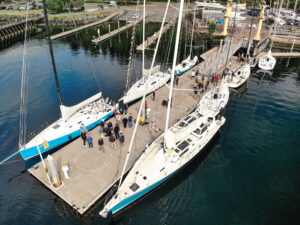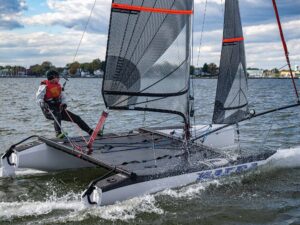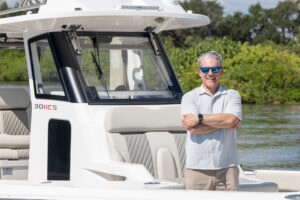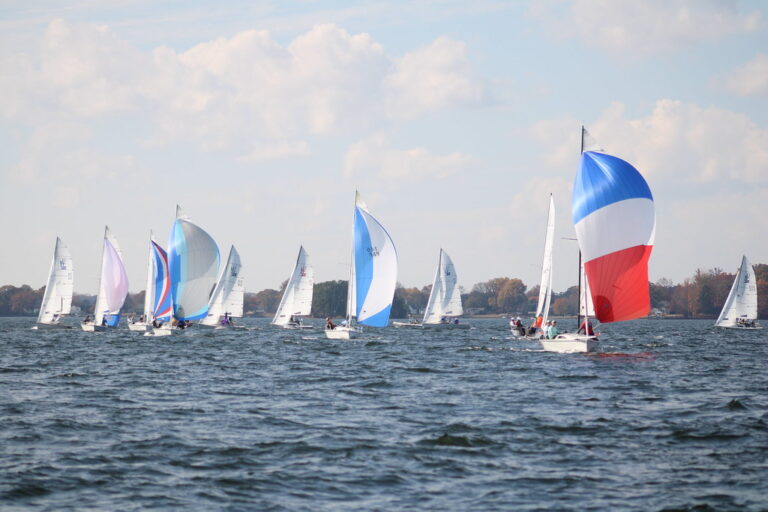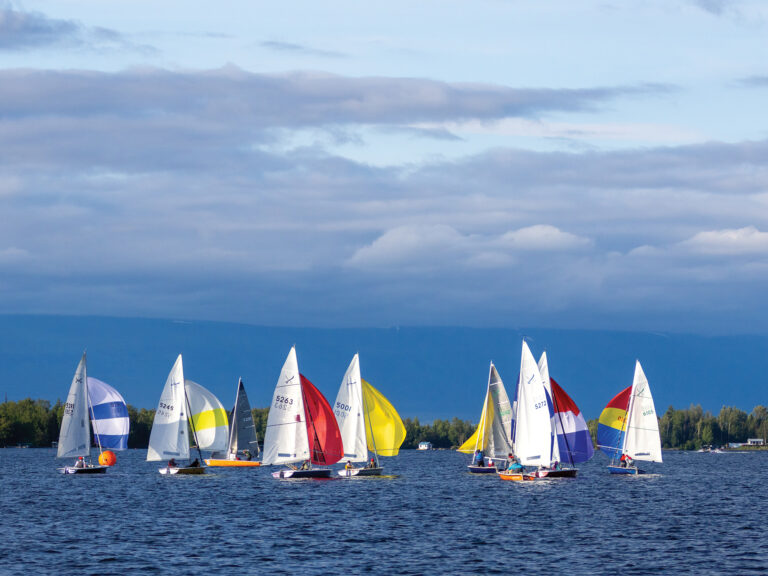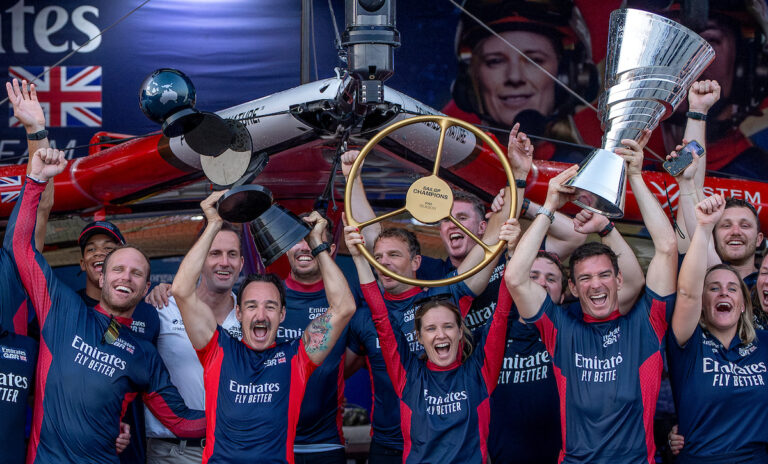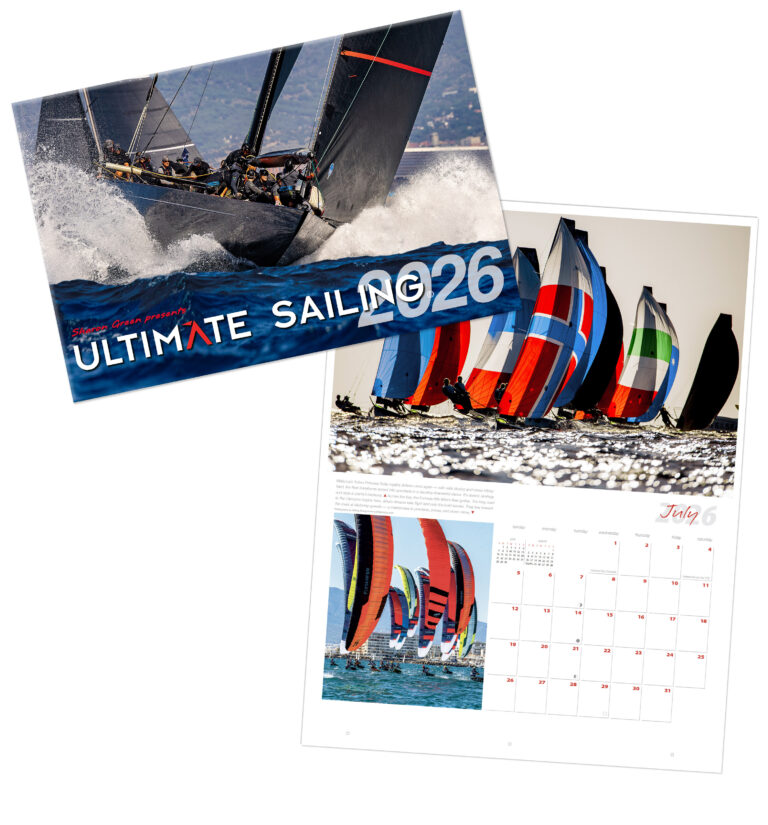J/88: Best One-Design
The sweet spot for J/Boats has always been the 30-foot range, and in years past they’ve had great runs with models like the J/29, the J/30, and the J/105. To meet the demands of owners today to be able to haul and store themselves, the team at J/Boats has come up with a design that’s more versatile than any like models before it. It’s not revolutionary, the judges say, but when it comes to practicality, it’s perfect. At roughly 5,000 pounds, the J/88 has a deck-stepped rig and a single-point lift so it can be hauled with a hoist and parked in the driveway—or put on the interstate for the occasional class championship.
The J/88 was originally conceptualized as a daysailer, says J/Boats president Jeff Johnstone, but that market got overpopulated so they seized an opportunity to revisit their range with a design that Johnstone says is a “family boat with high-performance traits.”
“The stability and sailing comfort are right there,” says Chuck Allen. “They really got this one right. It’s big enough, yet small enough, to do a lot with. For a boat its size, there’s a big interior, a really comfortable cockpit, and there’s nothing intimidating about it. Upwind, the thing just locks into a nice groove. It practically sailed itself.”
Tom Rich praised the quality continuing to come out of Bristol’s CCF Composites (also the J/70 builder). “I think it’s an incredibly well built boat,” says Rich. “There’s nothing negative we can say about it.”
Greg Stewart agreed, noting that the helm has great feel upwind and downwind. The interior, he adds, has plenty of sitting headroom, a lot of volume for a family to weekend, and the construction, right down to the finish, is excellent.
With a Hall Spars carbon rig and a low vertical center of gravity, the boat is plenty stiff. The cockpit is set up for shorthanded sailing and efficient buoy racing. To get the ergonomics right, they built a plug and fussed over hardware placement so the T-shaped cockpit is obstacle-free and uncluttered with lines.
Johnstone’s philosophy is to not immediately promote a new model as a one-design, but they were at hull No. 39 in the order book as of press time, and one-design class rules were in development.
“One-design doesn’t happen out of the box,” says Johnstone. “For us, it’s about matching a boat to people’s lifestyles, and right now that’s primarily beer-can racing. At some point soon, however, we will have J/88 racing happening.”
The boat will ideally be raced with a crew of five, or three couples, he adds, and the provisional PHRF rating of 87 seems like a reasonable starting point.
Click here to see more photos of the J/88.
DEHLER 38: Best Crossover
**
**
The Dehler 38 is one of those boats that will catch you off guard. It blends in at the marina or the mooring field, but on the racecourse, with good sails and a crew on the rail, it will catch the attention and the envy of your club competitors.
The judges agreed after their test sail that this 38-footer, built by Hanse Yachts in Germany, is the perfect crossover package for an owner looking for a boat with which he can do anything. It delivered on aesthetics and performance. With a clean, functional interior, and a reasonable price, the judges deemed it the best of the crossovers and best value of the entire BOTY fleet.
“The interior is amazing,” says Allen. “There’s really good quality throughout the boat, no cheap stuff on it whatsoever. But what really sold me was how well it sails.”
The Judel/Vrolijk team is responsible for the Dehler 38’s slippery shape, and while it’s modern and fast below the waterline, its beam gives substantial volume to the boat, which allows for standing headroom and a three-cabin layout. A few space-saving ideas help, including a nav-station desk that slides fore and aft, and a cabin door to the port side head that can be closed two ways. One way creates an enclosed head and the other creates an aft master stateroom.
“I felt like this is exactly the sort of boat that you could take anywhere and race,” says Stewart, “especially in the local overnight races that are popular these days. It sailed with a really nice groove, and I like the cockpit layout; everything is placed where it should be for a helmsman and his trimmers to do their jobs without getting in each other’s way. It’s wide aft and really clean. The steering system is nice and light, and I could see the telltales well from the helm.”
The competition version comes with a carbon rig and a deeper T-bulb keel. The test boat the judges sailed had the standard keel, and while they were impressed with the performance, they felt the competition model would be even better. “It’s a nice rounded shape that’s not submerged,” says Stewart. “That, combined with its powerful bow profile, makes it a boat that behaves really well.”
Deck hardware is all Harken, and the boat has masthead symmetric spinnaker gear, with the option to mount a sprit for an asymmetric. Either downwind setup will get you around the track quickly, and back to the club to collect your hardware.
Click here to see more photos of the Dehler 38.
RS CAT 16: Best Dinghy
If the America’s Cup inspired you to try catamaran sailing, RS Sailing, of England, has the boat to do it. The RS CAT16, a triumph of rotomolding technology, is not just another plastic beach cat. It’s plenty high-performance. This is one for adults and kids alike to get hooked on the stoke that comes with two hulls.
The biggest challenge with polyethylene boats, especially catamarans, is rigidity where the beams meet the hulls. To address this, RS designed the hull with a deep channel that runs the length of the hull. The beams are bolted through molded hull tubes, rather than directly fastened to the deck. This makes the hulls watertight.
The CAT16 is the first in a series to come and is available in two versions: the standard has a jib and main, and the XL, which the judges sailed, has a gennaker, as well as a single trapeze (a second trap is optional).
“It’s a great boat,” says Tom Rich. “I thought it was incredibly responsive, stiff, and well laid out.” Allen agrees, and adds, “With more breeze you’d be laughing, but what’s really amazing is the build and how well it’s all put together—amazing.”
At 300 pounds, it’s not the lightest beach cat, but RS wanted strength and longevity over weight, given the abuse beach cats get. The aluminum alloy rudders kick up, and there are no daggerboards to destroy during beach or dock landings. Long hull skegs are deep enough to minimize leeway.
RS aims for simplicity in every system, and that’s true with the CAT16; the mast easily pins to a ball on the forward beam, every halyard runs externally, and there’s minimal hardware. Trampoline pockets hide unused sheets and halyards, and there are proper safety elements, too, including a righting line and flotation in the mast.
It’s built using the same process they’ve used for more than 10,000 units: The outer layer has a UV stabilizer in the polyethylene, the middle layer is foam core, and the inner layer seals the whole thing.
The boat can accommodate four people, but it’s ideal for two. The RS CAT16 is also a boat on which one adult can go it alone with the main, jib, or gennaker and let their inner Spithill soar.
CATALINA SPORT 275: Best Recreational Racer
Catalina Yachts has built more boats than most builders could ever dream to—at least 75,000 at their last count. Over the years they’ve literally come up with everything from cruising boats to small trainers, but nothing ever with a sprit-flown asymmetric spinnaker. Adding a sportboat to their lineage was a long time coming. With the Catalina 275 Sport they’ve taken a big step toward catching up with the rest of the sport, but fear not Catalina enthusiasts. This may not be your grandfather’s Catalina, but it’s one we can assure you he’d happily own.
The design concept from Gerry Douglas, the builder’s long-standing in-house designer, is that of weekender, club racer, and daysailer. His vision was a first boat for young families, or a low-hassle boat for experienced owners downsizing from a larger boat. To get there he came up with a design that’s true to the Catalina ethos: simple, functional, and affordable.
The boat has accommodations to comfortably overnight or weekend, with a settee table up in the bow that drops to convert to a double berth. A galley to starboard with a drawer that fits a big cooler and an enclosed head to port bring it one level beyond roughing it. A cavernous starboard aft berth, says Douglas, was designed to fit a stand-up paddleboard—now that’s some California thinking. But the marquee feature, he adds, is the cockpit’s long bench seats, which are all about maximum-capacity harbor cruises and casual weeknight PHRF races. The standard rig package is an aluminum mast with a self-tacking jib. The retractable asymmetric spinnaker pole, which is bolted on the foredeck through Delrin collars, is optional but highly recommended.
“There’s a lot of boat for 27 feet,” says Tom Rich. “It was comfortable to sit there and drive from inside the boat, where you feel protected by the high cockpit coamings. It’s a bit on the heavy side [5,000 pounds], but it slipped along just fine.”
The test boat, which was not 100 percent finalized, was tested with a 4-foot-5-inch winged keel, which helped it track well at lower speeds but took away some responsiveness in the turns. Douglas said he would be changing it to a fin keel, which will help. Regardless, the judges were impressed with how well it sailed in their light-air test.
“Honestly, it sailed better than we thought it would, by a lot,” says Allen. “With the 15-horsepower Yanmar it motored really well, too. It’s a great little boat that does exactly what they set out to do—it’s a family boat that you can do a lot with.”
Click here to see more photos of the Catalina Sport 275.
TIWAL 3.2: Best Innovation
The “first high-performance inflatable sailing dinghy” from Tiwal, in Vannes, France, was the interesting new standout of the BOTY fleet. Any reservations the judges had were scuttled on the water. “The thing was a blast,” says Chuck Allen. “I couldn’t believe how well it sailed. You could have some serious fun with this, especially in big breeze.”
With a high-pressure hull the boat has remarkable stiffness for a 10-foot inflatable. An aluminum hiking frame attaches to the deck, and the 110-pound boat, rig, and foils pack into two bags. It retails for $6,250 with the larger, 75-sq.ft. sail.
Click here to see more photos of the Tiwal 3.2.
Xp 44: 2014 Boat of the Year
When an owner spends roughly half of a million dollars on a sailboat, he will expect it to be worth every hard-earned or inherited penny. He’ll want to admire it. He’ll want to stay aboard every chance he gets, and show it off to his mates at the club. Most importantly, though, he’ll want to know it’s built like a half-million dollar sailboat should be. And if it’s the Xp 44, he’ll want to race it hard, too.
Full credit for the boat’s seriously high quality goes to the designers, engineers, and craftsmen of X-Yachts in Denmark. The Xp 44, the judges agreed, is the real-deal big-boat crossover. Yes, it’s luxurious for a raceboat, and yes, it’s a performance cruiser at its core, but the elements that make it a great cruiser are the very same elements that make it a great boat to go the distance, in more ways than one.
“It’s amazing. This thing has the feel of a 60-footer,” says veteran Boat of the Year judge Chuck Allen. “The keel is nice and deep, and even though we tested it with delivery sails, it sailed awesome. It sailed the best of all the boats.”
With more than 30 years in the production boatbuilding business, X-Yachts has a cult following, especially in Europe, so it’s no surprise they’ve delivered more than 51 Xp 44s since the boat’s European launch in 2011. We’re told they have orders through hull No. 72. Top results in European handicap races against Swan 42s, TP52s, and the like confirm that given a good team and a proper sail inventory, the boat can easily be pushed beyond its rating (a preliminary Long Island Sound PHRF rating is a kind 31).
“I walked up to it, and it looked like a great yacht,” says naval architect and judge Greg Stewart. “It has an excellent profile and a bigger feel because it has that nice, wide, modern shape aft.”
Just shy of 44 feet overall—with a maximum beam slightly over 13 feet and light displacement of 19,000 pounds—it feels like a substantial boat. It’s conceived to sail “superbly” in all conditions, says X-Yachts dealer Bob Rogers, “which is what makes X-Yachts race winners and enjoyable fast cruisers as well.”
In a weight-saving change to its building technique, X-Yachts now uses a composite grid structure in the hull instead of a stainless-steel grid as they did in the past. “All that extra weight went into the T-bulb keel,” says the BOTY panel’s resident boatbuilder Tom Rich. “You can really feel it in the boat.”
For their test sail, representatives presented the boat with a full-batten delivery main and non-overlapping jib, and there was no spinnaker gear onboard. I was sure the absence of a proper downwind inventory would turn off the judges immediately, but not so. They were sold on its upwind performance alone.
“It has a great setup,” says Stewart, who has a keen eye to the efficiency of cockpit layouts. “The winches on this boat aren’t oversized, and they’re set up perfectly at the helm. The powered hydraulic backstay is huge for controlling this rig. An owner doing a lot of racing might find it better to put on three-speed winches to speed up the jibes.”
Belowdeck, the boat is open, bright, and airy, and designed such that the ends of the boat are relatively empty and light. The boat has a traditional three-cabin layout—forepeak and two aft with pipe cots if need be—and convertible amidships settees. The starboard nav station is on tracks and can be shifted fore or aft depending on its intended use. The salon table can also be easily removed for racing.
On deck, the boat’s versatility makes it ideal for distance and point-to-point racing. Configured to race with masthead symmetric spinnakers, the fixed bowsprit puts any asymmetric inventory well away from the effects of the mainsail. Sheeting angles and adjustments on the headsails are excellent, says Allen, and the powered backstay gives sailors a wide range to work with the rig. There was one electric pit winch on the test boat, which the judges say is a must for a cruising boat of this size.
The appearance of the Xp 44 is close to the X-Yachts “look” designer Niels Jeppesen has developed over the years, the judges say. That too is a positive, especially for loyal X-Yachts owners.

